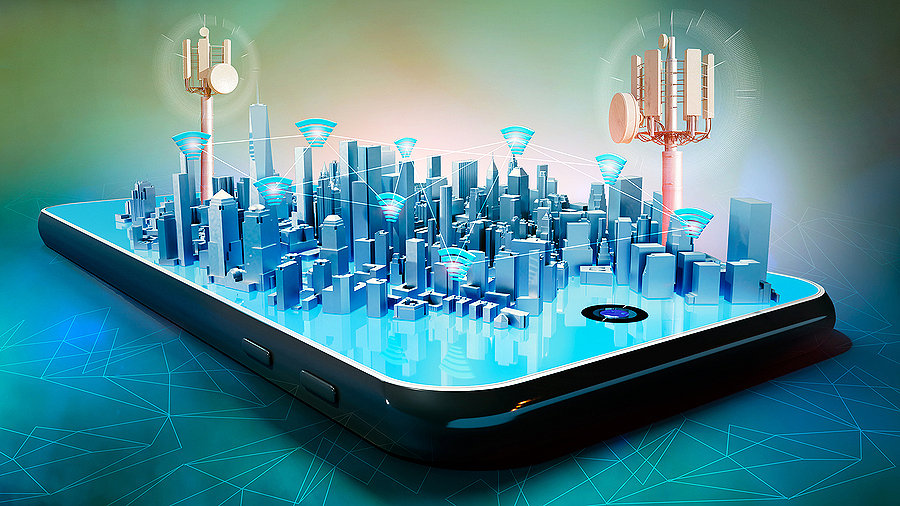IoT Technologies: Powering the Future of Smart Living

IoT technologies are transforming daily life, enabling automation across cities, buildings, transportation, retail, and healthcare. These advancements embed smart capabilities that prioritize convenience, safety, and efficiency, seamlessly connecting the physical and digital worlds. As demand for instant, intelligent interactions grows, IoT is evolving into a pervasive force that will continue to shape our future.
To meet this growing demand, data processing and AI must shift closer to the edge. Latency associated with traditional cloud-based systems limits real-time applications such as augmented reality, smart homes, and Vehicle-to-Everything (V2X) communications. The rise of edge data centers and advancements in wireless infrastructure like 5G-Advanced and 6G are crucial for ultra-low latency and increased bandwidth. These innovations rely on precision timing, which is fundamental for synchronizing networks and enabling high-speed data transmission.
Edge Datacenters and Precision Timing
Edge datacenters are pivotal to IoT’s future, requiring precise time synchronization for efficient operation. IEEE 1588 PTP technology relies on stable oscillators to filter time packets effectively. MEMS TCXOs outperform quartz TCXOs, offering 5x greater stability during temperature fluctuations. This stability ensures better performance in demanding environments like datacenters, where processors generate heat and require cooling.
As bandwidth requirements grow to 400G, 800G, and beyond, minimizing phase jitter becomes critical for data transmission. MEMS oscillators are 10x less sensitive to noise than quartz alternatives, making them ideal for modern networks. Additionally, their configurability supports lower power consumption, a key advantage for next-generation telecommunication.
MEMS in IoT Devices
Inside IoT devices, achieving optimal performance within strict size and power constraints is paramount. Devices like wearables, smart tags, and sensors require lightweight, compact designs to meet user expectations and operational needs. Traditional quartz crystals, limited by size and sensitivity to environmental factors, pose challenges for miniaturization. MEMS technology offers a solution with resonators that are up to 10x smaller and more resilient to shock and vibration.
MEMS-based oscillators also exhibit superior temperature stability, enhancing IoT performance in diverse environments. For instance, MEMS resonators can operate efficiently between -40°C and 125°C, making them ideal for both consumer and industrial applications.
Advancing Miniaturization with MEMS Technology
The miniaturization enabled by MEMS is driving IoT innovation. MEMS resonators are compact enough to be integrated into the same package as microcontrollers or system-on-chip (SoC) components, eliminating the need for separate housing. This level of integration is unattainable with quartz due to its reliance on external packaging and sensitivity to environmental stressors.
As IoT applications demand smaller, more efficient designs, MEMS-based products are setting new benchmarks for performance and scalability. By overcoming the limitations of traditional quartz oscillators, MEMS technology is empowering the next wave of intelligent IoT devices.
Most Asked Question in the FAQ
Networks (5)
GSM (Global System for Mobile Communications) is a standard developed by the European Telecommunications Standards Institute (ETSI) to describe the protocols for second-generation (2G) digital cellular networks used by mobile devices such as phones and tablets. Introduced in the 1990s, GSM was a major leap in mobile communication technology. Key aspects of GSM include:
- Digital Communication: GSM marked the transition from analog first-generation (1G) networks to digital, significantly improving voice quality, security, and capacity.
- Global Standard: As its name suggests, GSM became a global standard for mobile communication, facilitating international roaming and compatibility.
- Network Components: GSM networks consist of key subsystems like the Base Station Subsystem (BSS), Network and Switching Subsystem (NSS), and the Operations and Support Subsystem (OSS).
- SIM Cards: GSM introduced the use of SIM (Subscriber Identity Module) cards, which store subscriber data and facilitate mobile device identification and authentication on the network.
- Data Services: Besides voice communication, GSM supports data services such as SMS (Short Message Service) and later, GPRS (General Packet Radio Services) for basic internet connectivity.
- Encryption and Security: GSM networks employ encryption to secure voice and data communication, enhancing privacy and security.
- Frequency Bands: GSM operates in multiple frequency bands, like 900 MHz and 1800 MHz in Europe and 850 MHz and 1900 MHz in the Americas, catering to different regional requirements.
GSM set the foundation for modern mobile communication and led to the development of more advanced technologies like 3G (UMTS) and 4G (LTE).
How Mobile Roaming Service Keeps You Connected Anywhere
Roaming service enables mobile users to stay connected when outside their home network’s coverage area by allowing them to access visited networks. It allows automatic voice calls, text messaging, and data usage without manual reconfiguration.
This service is essential for uninterrupted communication when a user travels beyond their carrier’s regular service area. There are two main types of roaming: domestic and international. Domestic roaming occurs within the same country when a device connects to another operator’s network. International roaming applies when users access mobile services on a foreign operator’s network while traveling abroad. Roaming depends on agreements between mobile operators, covering service standards, data exchange, and pricing structures. These agreements make roaming services available across many countries and network partners.
Roaming ensures seamless connectivity, allowing users to use services like calls and data as they would at home. However, roaming may include additional charges, especially for international use, which vary based on the user’s plan. SIM card and device compatibility are critical, particularly with supported network technologies and frequency bands. Operators publish roaming coverage maps and lists of partner networks to inform subscribers about service availability.
In regions like the European Union, regulations protect consumers by capping roaming charges and increasing price transparency. Data roaming enables internet access and the use of mobile applications in foreign or partner networks. It can be costly, so users often have the option to disable data roaming through their device settings.
Roaming remains a vital component of global mobile connectivity, enabling users to access services across geographic and network boundaries.
- Types of Roaming:
- Domestic Roaming: Occurs when a user connects to another operator’s network within their home country.
- International Roaming: Involves using a mobile device on a foreign operator’s network while traveling abroad.
- Roaming Agreements: Mobile operators enter agreements with other operators to enable roaming for their subscribers. These agreements cover aspects like service standards, pricing, and data exchange.
- Seamless Connectivity: Roaming is designed to provide seamless service, with users able to use their mobile phones for calls, text messages, and data services just as they do at home.
- Charges and Tariffs: Roaming often incurs additional charges, which can vary significantly depending on the operators involved and the user’s service plan. International roaming, in particular, can be expensive.
- SIM Card and Network Compatibility: Effective roaming depends on the compatibility between the user’s mobile device and SIM card and the visited network, particularly in terms of supported frequency bands and network technologies.
- Roaming Partners and Coverage: Mobile operators typically publish lists of their roaming partners and the countries where roaming services are available.
- Regulatory Aspects: In some regions, like the European Union, regulations have been put in place to control roaming charges and protect consumers from high fees.
- Data Roaming: This allows users to access the internet and use data-driven services. Data roaming can be particularly costly, and users often have the option to disable it.
Brownfield networks refer to existing telecommunications networks that have been previously developed and deployed, often using legacy technologies and equipment. These networks contrast with “greenfield” networks, built from scratch using the latest technologies and standards. Key aspects of brownfield networks include:
- Legacy Systems: Brownfield networks often include older technologies that may not be compatible with the latest standards or innovations. This includes older generations of wireless technology, like 2G and 3G, or traditional wired networks.
- Integration Challenges: Integrating new technologies or upgrades into brownfield networks can be challenging due to compatibility issues with legacy systems and equipment.
- Cost Considerations: While upgrading brownfield networks can be cost-effective compared to building new infrastructure, the process of modernization can be complex and resource-intensive.
- Maintenance and Operations: Maintaining brownfield networks involves managing aging infrastructure, which may require more frequent repairs and upkeep.
- Migration to Newer Technologies: Transitioning from brownfield to more modern network infrastructures, like 4G, 5G, or fiber-optic networks, often requires strategic planning and phased implementation to minimize service disruptions.
- Customer Base: Brownfield networks typically have an existing customer base, which can be an advantage in terms of market presence, but also poses the challenge of ensuring service continuity during upgrades.
- Regulatory Compliance: Ensuring that brownfield networks comply with current regulatory standards is crucial, especially when integrating new technologies or services.
Understanding and effectively managing brownfield networks is essential for telecommunications operators, especially in the context of ongoing industry advancements and the need for digital transformation.
The official release dates of Wi-Fi 4, Wi-Fi 5, Wi-Fi 6, and Wi-Fi 7 (as per the IEEE standardization and Wi-Fi Alliance naming conventions) are as follows:
- Wi-Fi 4 (IEEE 802.11n):
- Standard Finalized: October 2009
- Wi-Fi 4 is the designation given to the IEEE 802.11n standard, which significantly improved upon previous Wi-Fi standards by introducing technologies like MIMO and increased data rates.
- Wi-Fi 5 (IEEE 802.11ac):
- Standard Finalized: January 2014 (Wave 1), December 2013 (Wave 2)
- Wi-Fi 5 refers to the IEEE 802.11ac standard, which enhanced Wi-Fi performance further by introducing features like wider channel bandwidth and support for additional spatial streams.
- Wi-Fi 6 (IEEE 802.11ax):
- Standard Finalized: September 2019
- Wi-Fi 6, known technically as IEEE 802.11ax, brought significant advancements in efficiency, especially in crowded environments, and introduced technologies like OFDMA and Target Wake Time (TWT).
- Wi-Fi 7 (IEEE 802.11be):
- Expected Finalization: As of my last update in April 2023, Wi-Fi 7 (IEEE 802.11be) was still in development, with finalization expected around 2024.
- Wi-Fi 7 is expected to offer further improvements in terms of data rates, latency, and efficiency, continuing the evolution of Wi-Fi technology.
These release dates mark important milestones in the development of Wi-Fi technology, with each new generation bringing enhancements that have enabled faster speeds, greater capacity, and more efficient network performance.
Greenfield networks refer to telecommunications networks built from scratch with no constraints from existing systems or infrastructures. This term is often used in contrast to “brownfield” networks, which involve upgrading or integrating with existing network infrastructure. Key aspects of greenfield networks include:
- Latest Technologies: Greenfield projects offer the opportunity to deploy the latest technologies, such as 5G in wireless networks or advanced fiber optics in wired networks, without the limitations of legacy systems.
- Design and Implementation Flexibility: Building a greenfield network allows for more flexibility in design and implementation, enabling a more optimized and efficient network architecture that is future-proof.
- Cost Considerations: While the initial investment for a greenfield project might be high due to the need for new infrastructure, it can be more cost-effective in the long term due to lower maintenance and operational costs.
- Faster Deployment of Advanced Services: Greenfield networks can more rapidly deploy advanced services and applications, benefiting from the inherent efficiencies and capabilities of the latest technologies.
- Challenges in Market Penetration: For new operators, establishing a greenfield network can be challenging in terms of gaining market share and attracting customers, especially in regions with established competitors.
- Regulatory Compliance: Greenfield projects must comply with all current regulatory standards and requirements, which can vary depending on the region and the type of services offered.
- Sustainability and Environmental Considerations: New network deployments can incorporate sustainability practices and eco-friendly technologies from the outset.
Greenfield networks represent an ideal scenario for deploying the most advanced telecommunications technologies and can set the foundation for innovative services and applications. They are particularly relevant in areas without existing telecommunications infrastructure or where the existing infrastructure is insufficient to meet current and future demands.
WIreless Technologies (1)
GSM (Global System for Mobile Communications) is a standard developed by the European Telecommunications Standards Institute (ETSI) to describe the protocols for second-generation (2G) digital cellular networks used by mobile devices such as phones and tablets. Introduced in the 1990s, GSM was a major leap in mobile communication technology. Key aspects of GSM include:
- Digital Communication: GSM marked the transition from analog first-generation (1G) networks to digital, significantly improving voice quality, security, and capacity.
- Global Standard: As its name suggests, GSM became a global standard for mobile communication, facilitating international roaming and compatibility.
- Network Components: GSM networks consist of key subsystems like the Base Station Subsystem (BSS), Network and Switching Subsystem (NSS), and the Operations and Support Subsystem (OSS).
- SIM Cards: GSM introduced the use of SIM (Subscriber Identity Module) cards, which store subscriber data and facilitate mobile device identification and authentication on the network.
- Data Services: Besides voice communication, GSM supports data services such as SMS (Short Message Service) and later, GPRS (General Packet Radio Services) for basic internet connectivity.
- Encryption and Security: GSM networks employ encryption to secure voice and data communication, enhancing privacy and security.
- Frequency Bands: GSM operates in multiple frequency bands, like 900 MHz and 1800 MHz in Europe and 850 MHz and 1900 MHz in the Americas, catering to different regional requirements.
GSM set the foundation for modern mobile communication and led to the development of more advanced technologies like 3G (UMTS) and 4G (LTE).




























































